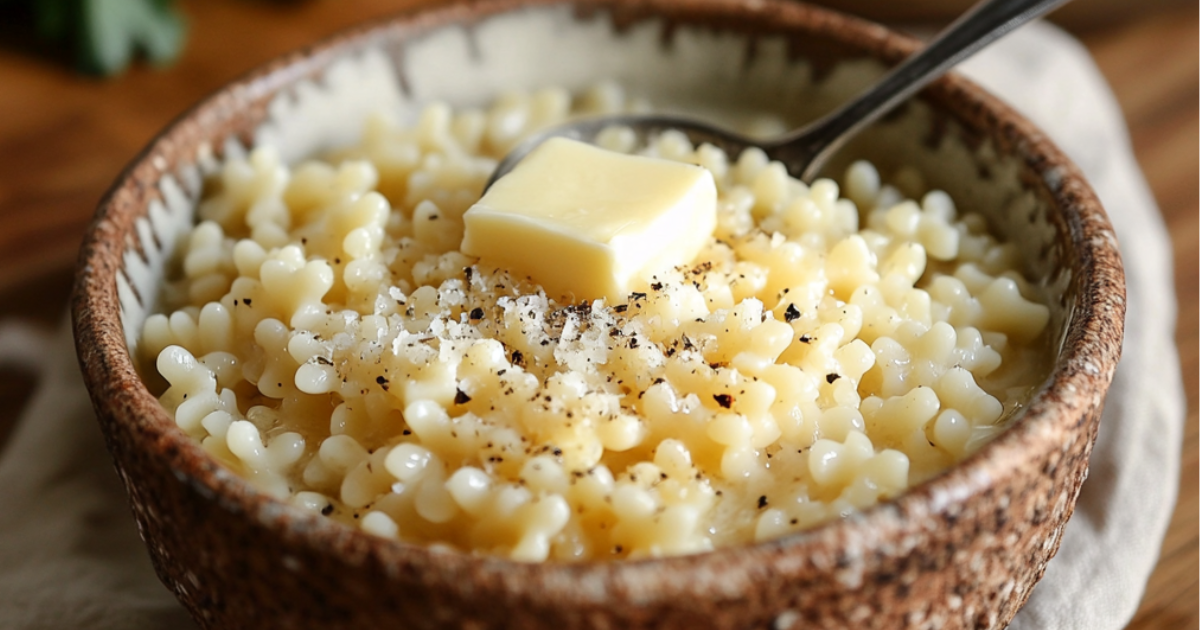Introduction: The Comfort of a Warm Bowl
There’s something undeniably soothing about a warm bowl of pastina. Whether it reminds you of childhood or it’s your go-to meal on chilly nights, this tiny pasta dish brings instant comfort. It’s simple yet satisfying, creamy yet light, and incredibly easy to make.
But here’s the thing—not all pastina is created equal. If you’ve ever had a bowl that turned out too watery, too thick, or just missing that velvety texture, you’re not alone. The secret to the perfect bowl of pastina lies in a few small techniques that make a big difference.
In this guide, you’ll learn how to make pastina with seven essential tips that guarantee a rich, creamy, and absolutely delicious result.
Table of Contents
What is Pastina?
Before diving into the step-by-step process, let’s cover the basics.
- Pastina means “little pasta” in Italian. These tiny pasta shapes—often stars, dots, or small tubes—are commonly used in soups or creamy dishes.
- It’s considered a comfort food in many Italian households, often served to children as one of their first solid meals.
- Traditional pastina recipes include simple ingredients like broth, butter, cheese, and sometimes eggs, making it both easy and satisfying.
- The texture can range from soupy to creamy, depending on how much liquid you use and how you cook it.
If you’re wondering how to make pastina the right way, keep reading for all the essential tips!

Ingredients for the Creamiest Pastina
To master how to make pastina, start with high-quality ingredients.
| Ingredient | Quantity |
|---|---|
| Pastina (tiny pasta) | ½ cup |
| Water or Broth | 2 cups |
| Butter | 1 tbsp |
| Milk (or heavy cream) | ¼ cup |
| Parmesan Cheese (grated) | 2 tbsp |
| Egg (optional) | 1 |
| Salt & Pepper | To taste |
💡 Want a richer flavor? Use homemade broth instead of water!
How to Make Pastina Perfectly: 7 Essential Tips
1. Cook the Pastina in Just Enough Liquid
Many people boil pastina like regular pasta and drain the excess water—but that’s a mistake! Instead, treat it like risotto, letting it absorb liquid as it cooks.
How to do it:
- Use 2 cups of broth or water for every ½ cup of pastina.
- Simmer on low heat, stirring occasionally, until the pasta absorbs most of the liquid.
- If needed, add small amounts of warm broth to reach your desired consistency.
By using this method, you’ll never wonder how to make pastina creamy again!
2. Stir in Butter for Richness
Butter is a simple addition that transforms pastina into something silky and flavorful. Adding it while the pasta is still hot ensures it melts evenly.
💡 Use unsalted butter if cooking with broth to control the saltiness!
3. Swap Some Water for Milk or Cream
If you want pastina to be extra creamy, replace part of the cooking liquid with milk or heavy cream.
Best options:
✔️ Whole milk – for a rich but not heavy consistency.
✔️ Heavy cream – for an ultra-creamy texture.
✔️ Oat or almond milk – for a dairy-free alternative.
💡 Warm the milk before adding it to prevent curdling!
4. Whisk in an Egg for a Velvety Texture
A classic Italian trick for how to make pastina extra creamy is whisking in an egg. The egg cooks gently in the hot pasta, creating a silky texture similar to carbonara.
How to do it:
- Whisk one egg in a separate bowl.
- Slowly drizzle it into the warm (but not boiling) pastina, stirring constantly.
- Keep mixing until it’s fully incorporated and smooth.
💡 Do this at the very end to avoid scrambling the egg!
5. Finish with Parmesan for Extra Flavor
Parmesan cheese adds both creaminess and a savory depth. For best results:
✔️ Use finely grated cheese – It melts faster and blends better.
✔️ Add it last – Mixing it in too early can create clumps.
✔️ Use Pecorino Romano – If you like a sharper, saltier taste.
💡 If your pastina is too thick, add a splash of broth before serving!
6. Adjust the Consistency to Your Liking
One of the best things about pastina is that you can make it as thick or thin as you want.
✔️ For a soupier version: Add extra broth while cooking.
✔️ For a thicker version: Let it sit for a few minutes before serving.
✔️ For a middle-ground texture: Use the egg and cheese method for a risotto-like consistency.
💡 Pastina thickens as it cools, so always serve immediately!
7. Serve Fresh for the Best Texture
If you’ve ever reheated pastina and found it turned into a thick lump, you’re not alone. Unlike other pasta dishes, pastina changes consistency quickly. Over time, it absorbs liquid and becomes thicker, so it’s best eaten fresh.
💡 If reheating, add a little broth or milk to bring back the creamy texture!
FAQ – Your Pastina Questions Answered!
1. How to make pastina without milk or cheese?
You can cook pastina in broth and finish it with olive oil for a dairy-free option.
2. What’s the best type of pastina?
Stelline (star-shaped pasta) is a favorite, but orzo, acini di pepe, and ditalini also work well.
3. Can I reheat pastina?
Yes, but it thickens over time. Add a splash of warm broth or milk while reheating.
4. Can I freeze pastina?
Freezing changes its texture, so it’s best eaten fresh. If needed, freeze without dairy and add milk after reheating.
5. How to make pastina for babies?
Cook it in water or unsalted broth and keep it soft. You can mix in a little butter or a mild cheese like ricotta.
Conclusion: Master How to Make Pastina Like a Pro
Now that you know how to make pastina the right way, you can enjoy the creamiest, coziest bowl every time! By following these seven tips, you’ll never have to deal with bland or overcooked pastina again.
Try out these techniques, experiment with flavors, and make this classic comfort food your own.
💬 How do you like your pastina? Share your favorite variations in the comments!
🔄 Loved this guide? Share it with family and friends!

